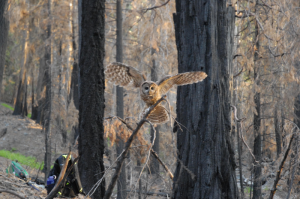
While much of the public, and many politicians, believe that high-severity fires destroy wildlife habitat and promote insect infestations, the science proves otherwise. But this false assumption that fire and insects are destructive to wildlife is providing the underlying basis for increased logging. And yet thinning in the name of fire reduction and salvage logging of burned trees is actually the greatest threat to the forest ecosystem.
Today we talk with Monica Bond, a wildlife biologist and biodiversity advocate with the Wild Nature Institute, about the wonders of post-fire forests and why logging them prior to or after a burn causes more harm than good.
Monica Bond is a wildlife biologist and biodiversity advocate with the Wild Nature Institute and a research associate with the University of Zurich. She has conducted field research on gray-tailed voles, Western Burrowing Owls, Spotted Owls, Black-backed Woodpeckers, arboreal salamanders, northern elephant seals, Hawaiian monk seals, and Masai giraffes. Monica has studied California Spotted Owls since 1999, and in 2011 also conducted field research on Black-Backed Woodpeckers. She served on the Dry Forest Landscapes Working Group for the Northern Spotted Owl Recovery Plan. She has published more than 45 peer-reviewed scientific journal articles and book chapters. She published 11 peer-reviewed articles on Spotted Owls and wildfire.
Watch a video of Black Backed Woodpeckers, Mountain Blue Birds and other birds attracted to intense burns after the fires have burned out. This video was made by a crew that Monica Bond took into the woods in Northern California several years ago.
Photo of spotted owl by Rachel Fazio.
- KBOO


